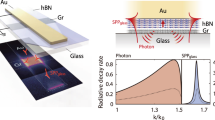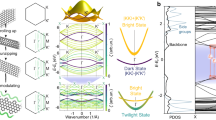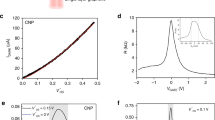Abstract
Plasmonic tunnel junctions are a unique electroluminescent system in which light emission occurs via an interplay between tunnelling electrons and plasmonic fields instead of electron–hole recombination as in conventional light-emitting diodes. It was previously shown that placing luminescent molecules in the tunneling pathway of nanoscopic tunnel junctions results in peculiar upconversion electroluminescence where the energy of emitted photons exceeds that of excitation electrons. Here we report the observation of upconversion electroluminescence in macroscopic van der Waals plasmonic tunnel junctions comprising gold and few-layer graphene electrodes separated by a ~2-nm-thick hexagonal boron nitride tunnel barrier and a monolayer semiconductor. We find that the semiconductor ground exciton emission is triggered at excitation electron energies lower than the semiconductor optical gap. Interestingly, this upconversion is reached in devices operating at a low conductance (<10−6 S) and low power density regime (<102 W cm−2), defying explanation through existing proposed mechanisms. By examining the scaling relationship between plasmonic and excitonic emission intensities, we elucidate the role of inelastic electron tunnelling dipoles that induce optically forbidden transitions in the few-layer graphene electrode and ultrafast hot carrier transfer across the van der Waals interface.
This is a preview of subscription content, access via your institution
Access options
Access Nature and 54 other Nature Portfolio journals
Get Nature+, our best-value online-access subscription
$29.99 / 30 days
cancel any time
Subscribe to this journal
Receive 12 print issues and online access
$259.00 per year
only $21.58 per issue
Buy this article
- Purchase on Springer Link
- Instant access to full article PDF
Prices may be subject to local taxes which are calculated during checkout




Similar content being viewed by others
Data availability
All data are available in the article and the Supplementary Information, and are available from the corresponding authors on reasonable request.
Code availability
The source code for the calculations conducted in this study is available from the corresponding authors on reasonable request.
References
Lambe, J. & McCarthy, S. L. Light emission from inelastic electron tunneling. Phys. Rev. Lett. 37, 923–925 (1976).
Du, W., Wang, T., Chu, H.-S. & Nijhuis, C. A. Highly efficient on-chip direct electronic–plasmonic transducers. Nat. Photon. 11, 623–627 (2017).
Qian, H. et al. Efficient light generation from enhanced inelastic electron tunnelling. Nat. Photon. 12, 485–488 (2018).
Parzefall, M. et al. Antenna-coupled photon emission from hexagonal boron nitride tunnel junctions. Nat. Nanotechnol. 10, 1058–1063 (2015).
Flaxer, E., Sneh, O. & Cheshnovsky, O. Molecular light emission induced by inelastic electron tunneling. Science 262, 2012–2014 (1993).
Wu, S., Nazin, G. & Ho, W. Intramolecular photon emission from a single molecule in a scanning tunneling microscope. Phys. Rev. B 77, 205430 (2008).
Schuler, B. et al. Electrically driven photon emission from individual atomic defects in monolayer WS2. Sci. Adv. 6, eabb5988 (2020).
Lutz, T. et al. Molecular orbital gates for plasmon excitation. Nano Lett. 13, 2846–2850 (2013).
Doppagne, B. et al. Vibronic spectroscopy with submolecular resolution from STM-induced electroluminescence. Phys. Rev. Lett. 118, 127401 (2017).
Doppagne, B. et al. Electrofluorochromism at the single-molecule level. Science 361, 251–255 (2018).
Merino, P. et al. Bimodal exciton–plasmon light sources controlled by local charge carrier injection. Sci. Adv. 4, eaap8349 (2018).
Merino, P., Große, C., Rosławska, A., Kuhnke, K. & Kern, K. Exciton dynamics of C60-based single-photon emitters explored by Hanbury Brown–Twiss scanning tunnelling microscopy. Nat. Commun. 6, 8461 (2015).
Kuhnke, K., Große, C., Merino, P. & Kern, K. Atomic-scale imaging and spectroscopy of electroluminescence at molecular interfaces. Chem. Rev. 117, 5174–5222 (2017).
Gutzler, R., Garg, M., Ast, C. R., Kuhnke, K. & Kern, K. Light–matter interaction at atomic scales. Nat. Rev. Phys. 3, 441–453 (2021).
Dong, Z. C. et al. Generation of molecular hot electroluminescence by resonant nanocavity plasmons. Nat. Photon. 4, 50–54 (2010).
Chen, G. et al. Spin-triplet-mediated up-conversion and crossover behavior in single-molecule electroluminescence. Phys. Rev. Lett. 122, 177401 (2019).
Schull, G., Néel, N., Johansson, P. & Berndt, R. Electron–plasmon and electron–electron interactions at a single atom contact. Phys. Rev. Lett. 102, 057401 (2009).
Peters, P.-J. et al. Quantum coherent multielectron processes in an atomic scale contact. Phys. Rev. Lett. 119, 066803 (2017).
Schneider, N. L., Schull, G. & Berndt, R. Optical probe of quantum shot-noise reduction at a single-atom contact. Phys. Rev. Lett. 105, 026601 (2010).
Kalathingal, V., Dawson, P. & Mitra, J. Scanning tunnelling microscope light emission: finite temperature current noise and over cut-off emission. Sci. Rep. 7, 1–10 (2017).
Buret, M. et al. Spontaneous hot-electron light emission from electron-fed optical antennas. Nano Lett. 15, 5811–5818 (2015).
Parzefall, M. et al. Light from van der Waals quantum tunneling devices. Nat. Commun. 10, 292 (2019).
Sun, J. et al. Light-emitting plexciton: exploiting plasmon–exciton interaction in the intermediate coupling regime. ACS Nano 12, 10393–10402 (2018).
Péchou, R. et al. Plasmonic-induced luminescence of MoSe2 monolayers in a scanning tunneling microscope. ACS Photon. 7, 3061–3070 (2020).
Qi, P. et al. Giant excitonic upconverted emission from two-dimensional semiconductor in doubly resonant plasmonic nanocavity. Light. Sci. Appl. 11, 176 (2022).
Froehlicher, G., Lorchat, E. & Berciaud, S. Charge versus energy transfer in atomically thin graphene-transition metal dichalcogenide van der Waals heterostructures. Phys. Rev. 8, 011007 (2018).
Jeong, T. Y. et al. Spectroscopic studies of atomic defects and bandgap renormalization in semiconducting monolayer transition metal dichalcogenides. Nat. Commun. 10, 3825 (2019).
Wang, Z., Kalathingal, V., Hoang, T. X., Chu, H.-S. & Nijhuis, C. A. Optical anisotropy in van der Waals materials: impact on direct excitation of plasmons and photons by quantum tunneling. Light. Sci. Appl. 10, 230 (2021).
Lieb, M. A., Zavislan, J. M. & Novotny, L. Single-molecule orientations determined by direct emission pattern imaging. J. Opt. Soc. Am. B 21, 1210–1215 (2004).
Román, R. J. P. et al. Electroluminescence of monolayer WS2 in a scanning tunneling microscope: effect of bias polarity on spectral and angular distribution of emitted light. Phys. Rev. B 106, 085419 (2022).
Schuller, J. A. et al. Orientation of luminescent excitons in layered nanomaterials. Nat. Nanotechnol. 8, 271–276 (2013).
Wang, J., Verzhbitskiy, I. & Eda, G. Electroluminescent devices based on 2D semiconducting transition metal dichalcogenides. Adv. Mater. 30, 1802687 (2018).
Dobusch, L., Schuler, S., Perebeinos, V. & Mueller, T. Thermal light emission from monolayer MoS2. Adv. Mater. 29, 1701304 (2017).
Zhou, Y. et al. Probing dark excitons in atomically thin semiconductors via near-field coupling to surface plasmon polaritons. Nat. Nanotechnol. 12, 856–860 (2017).
Wang, S. et al. Efficient carrier-to-exciton conversion in field emission tunnel diodes based on MIS-type van der Waals heterostack. Nano Lett. 17, 5156–5162 (2017).
Tielrooij, K. et al. Electrical control of optical emitter relaxation pathways enabled by graphene. Nat. Phys. 11, 281–287 (2015).
Federspiel, F. et al. Distance dependence of the energy transfer rate from a single semiconductor nanostructure to graphene. Nano Lett. 15, 1252–1258 (2015).
Koppens, F. H., Chang, D. E. & García de Abajo, F. J. Graphene plasmonics: a platform for strong light–matter interactions. Nano Lett. 11, 3370–3377 (2011).
Gonçalves, P. A. D. et al. Plasmon–emitter interactions at the nanoscale. Nat. Commun. 11, 366 (2020).
Yuan, L. et al. Photocarrier generation from interlayer charge-transfer transitions in WS2-graphene heterostructures. Sci. Adv. 4, e1700324 (2018).
Chen, Y., Li, Y., Zhao, Y., Zhou, H. & Zhu, H. Highly efficient hot electron harvesting from graphene before electron–hole thermalization. Sci. Adv. 5, eaax9958 (2019).
Swathi, R. & Sebastian, K. Long range resonance energy transfer from a dye molecule to graphene has (distance)−4 dependence. J. Chem. Phys. 130, 086101 (2009).
Gaudreau, L. et al. Universal distance-scaling of nonradiative energy transfer to graphene. Nano Lett. 13, 2030–2035 (2013).
Dias, E. J. et al. Probing nonlocal effects in metals with graphene plasmons. Phys. Rev. B 97, 245405 (2018).
Linardy, E., Trushin, M., Watanabe, K., Taniguchi, T. & Eda, G. Electro‐optic upconversion in van der Waals heterostructures via nonequilibrium photocarrier tunneling. Adv. Mater. 32, 2001543 (2020).
Brotons-Gisbert, M. et al. Out-of-plane orientation of luminescent excitons in two-dimensional indium selenide. Nat. Commun. 10, 3913 (2019).
Acknowledgements
We acknowledge the support from the Ministry of Education (MOE), Singapore, under Academic Research Fund (AcRF) Tier 3 (grant no. MOE2018-T3-1-005), and the National Research Foundation (NRF), under the Prime Minister’s Office, Singapore, under the Medium Sized Centre Programme and the Competitive Research Programme (CRP) (grant no. NRF-CRP17-2017-08). M.T. acknowledges Institute for Functional Intelligent Materials (I-FIM, grant no. EDUNC-33-18-279-V12). B.Ö. acknowledges the Singapore NRF Investigatorship (grant no. NRF-NRFI2018-8) and MOE-AcRF-Tier 2 (grant no. MOE-T2EP50220-0017). J.W. acknowledges the National Key R&D Program of China (grant no. 2021YFA1200804).
Author information
Authors and Affiliations
Contributions
G.E., Z.W. and V.K. conceived the project. Z.W. and J.L. fabricated the devices. Z.W. performed the measurements. Z.W. and V.K. analysed the experimental data. V.K., M.T. and Z.W. performed the theoretical analysis. G.E. and C.A.N. co-supervised the project. Z.W., V.K. and G.E. co-wrote the paper. G.E., C.A.N, Y.G. and B.Ö. provided equipment and laboratory facilities. All authors contributed to the scientific discussions and paper revisions.
Corresponding authors
Ethics declarations
Competing interests
The authors declare no competing interests.
Peer review
Peer review information
Nature Nanotechnology thanks the anonymous reviewers for their contribution to the peer review of this work.
Additional information
Publisher’s note Springer Nature remains neutral with regard to jurisdictional claims in published maps and institutional affiliations.
Supplementary information
Supplementary Information
Supplementary Figs. 1–14 and discussion.
Rights and permissions
Springer Nature or its licensor (e.g. a society or other partner) holds exclusive rights to this article under a publishing agreement with the author(s) or other rightsholder(s); author self-archiving of the accepted manuscript version of this article is solely governed by the terms of such publishing agreement and applicable law.
About this article
Cite this article
Wang, Z., Kalathingal, V., Trushin, M. et al. Upconversion electroluminescence in 2D semiconductors integrated with plasmonic tunnel junctions. Nat. Nanotechnol. (2024). https://doi.org/10.1038/s41565-024-01650-0
Received:
Accepted:
Published:
DOI: https://doi.org/10.1038/s41565-024-01650-0



